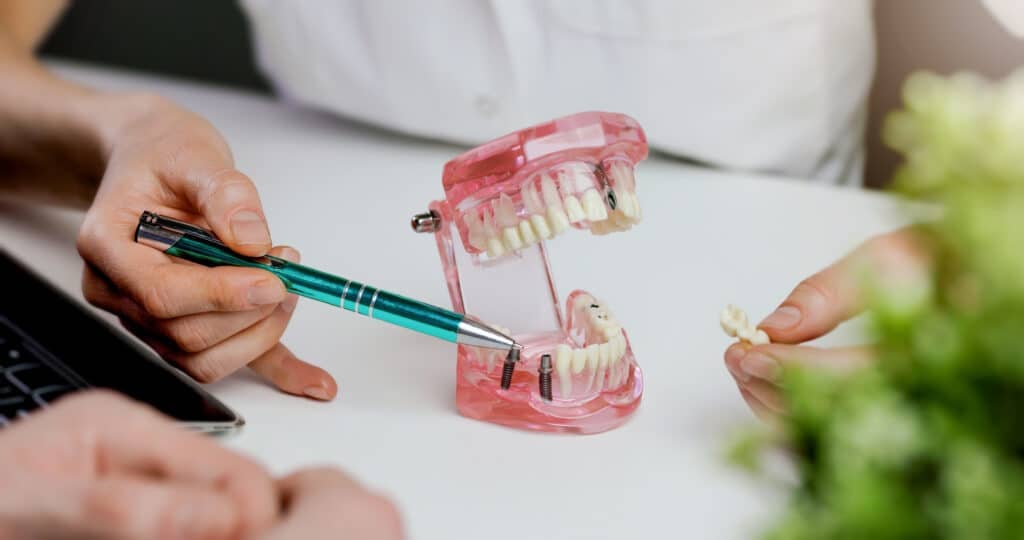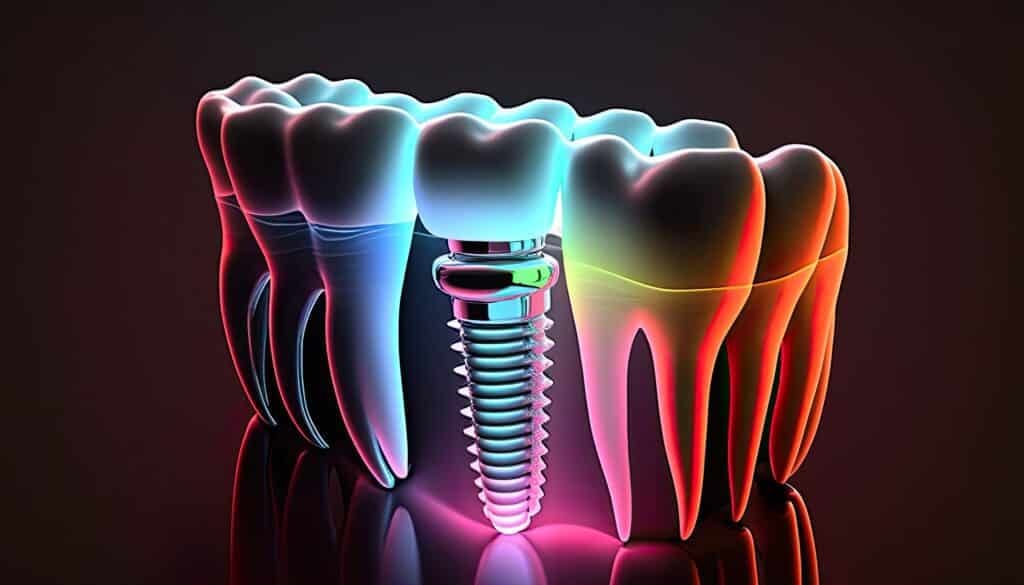Different Dentists
Dentists use different techniques for installing dental implants and the type of techniques they use will dictate how many can be installed in one visit. One treatment allows for four dental implants to be put in a day. This procedure calls for the four implants to be together so they create a functional section. The overall recommendation is to not do more than eight teeth on top and eight below at one time. That will give the patient a full set of teeth on the lower and upper jaw. A concern for dentists is the amount of anesthesia needed for the procedure, the amount of pain such a procedure would cause, and the overall function immediately after the procedure.
The cost and time the procedure would take is also a concern for both dentists and patients. One key factor is jawbone growth. The jawbone has to grow to reach each implant. Having implants on separate days rather than all at once allows time for growth.
The overall recommendation is to not do more than eight teeth on top and eight below at one time. That will give the patient a full set of teeth on the lower and upper jaw. A concern for dentists is the amount of anesthesia needed for the procedure, the amount of pain such a procedure would cause, and the overall function immediately after the procedure.
The cost and time the procedure would take is also a concern for both dentists and patients. One key factor is jawbone growth. The jawbone has to grow to reach each implant. Having implants on separate days rather than all at once allows time for growth.
The Length of Implant Treatment.
Getting one implant can take up to two hours but the process is made easier with digital mapping. Your dentist will do some digital photos and X-rays to map out exactly where the implant should go. The most complicated part of the process is inserting the metal post in the jawbone that serves as a root. Then the tooth cap is placed over the post. Those having several implants done can estimate one to two hours per implant. You can ask your dentist how long the process will take when working with multiple implants. It could be that you can’t sit in the dental chair that long and may opt to break up the procedures. The length of time you must sit still is a factor to consider. One of the concerning factors that dentists and dental surgeons must consider is the overall treatment time of implants. The implant procedure isn’t one-and-done. The surgery is just one aspect of getting dental implants
Standard treatment for dental patients getting implants is anywhere from three to 15 months. The teeth will need to be extracted first. A dentist can pull all teeth at once because there isn’t a limit. However, considering the discomfort and other factors, a dentist may opt to extract the teeth over several sessions.
A dental surgeon may insert bone grafts in the jawbone during the extraction process. This is to prepare the jaw for the dental implant.
Once teeth are extracted, a dental patient must wait about three months before the implant surgery can take place. The wounds from the extractions need to heal before an implant can be performed.
A complicated case involving multiple teeth may require multiple surgeries or various treatments to get dental implants. That can stretch out the total treatment period.
One of the concerning factors that dentists and dental surgeons must consider is the overall treatment time of implants. The implant procedure isn’t one-and-done. The surgery is just one aspect of getting dental implants
Standard treatment for dental patients getting implants is anywhere from three to 15 months. The teeth will need to be extracted first. A dentist can pull all teeth at once because there isn’t a limit. However, considering the discomfort and other factors, a dentist may opt to extract the teeth over several sessions.
A dental surgeon may insert bone grafts in the jawbone during the extraction process. This is to prepare the jaw for the dental implant.
Once teeth are extracted, a dental patient must wait about three months before the implant surgery can take place. The wounds from the extractions need to heal before an implant can be performed.
A complicated case involving multiple teeth may require multiple surgeries or various treatments to get dental implants. That can stretch out the total treatment period.
The Latest Techniques
You may hear dentists talk about All-on-4 implants. This allows for an entire teeth set to be replaced. The typical number of teeth replaced in this procedure is 14 including two canines, four molars, four premolars, and 4 incisors. The thing that this procedure does is it provides better function than dentures without adhesives or removing them for cleaning at night. This procedure also offers advantages over dentures because it irritates the gums less, doesn’t affect taste, and works well for those with gag reflexes. New dental technology happens constantly now. This includes using 3D milling and printing to create implants, and implant surgery guided by computers. Implant restorations are also digitally designed and milled in many instances now. These new procedures make designing custom things like implants, bridges, and crowns better than ever since they are designed for one specific patient’s mouth. CBCT scanning digitally maps out your mouth and teeth positions so a simulated model with the new teeth can be created to show patients how their mouth will look after treatment.
Using digitally designed products in restoration reduces the time a person goes without teeth and keeps the patient’s gums and structure intact. Dental surgeons can combine digital procedures with conventional ones to create an effective oral care treatment plan.
Those who are missing teeth or have several decayed ones can call us to discuss all your options for getting rid of the decay, and improving your oral health and your smile with dental implants.
These new procedures make designing custom things like implants, bridges, and crowns better than ever since they are designed for one specific patient’s mouth. CBCT scanning digitally maps out your mouth and teeth positions so a simulated model with the new teeth can be created to show patients how their mouth will look after treatment.
Using digitally designed products in restoration reduces the time a person goes without teeth and keeps the patient’s gums and structure intact. Dental surgeons can combine digital procedures with conventional ones to create an effective oral care treatment plan.
Those who are missing teeth or have several decayed ones can call us to discuss all your options for getting rid of the decay, and improving your oral health and your smile with dental implants.